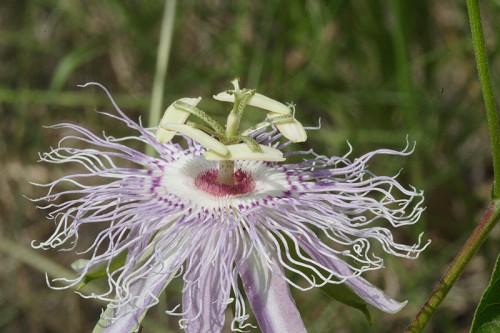Passiflora incarnata
Common name: purple passionflower [1], maypop [2]
| Passiflora incarnata | |
|---|---|

| |
| Photo by John Gwaltney hosted at Southeastern Flora.com | |
| Scientific classification | |
| Kingdom: | Plantae |
| Division: | Magnoliophyta - Flowering plants |
| Class: | Magnoliopsida - Dicots |
| Order: | Violales |
| Family: | Passifloraceae |
| Genus: | Passiflora |
| Species: | P. incarnata |
| Binomial name | |
| Passiflora incarnata L. | |

| |
| Natural range of Passiflora incarnata from USDA NRCS Plants Database. | |
Contents
Taxonomic Notes
Synonyms: none
Varieties: none
Description
P. incarnata is a perennial forb/herb/vine of the Passifloraceae family native to North America. [1]
Distribution
P. incarnata is found in the southeastern corner of the United States. [1]
Ecology
Habitat
P. incarnata proliferates in roadsides, fencerows, thickets, and fields. [2] Specimens have been collected from pine flatwoods, fields, roadside, live oak hammock, old field, sandysoils, fence row, open pasture, waste area, old brick wall, and shore of lake. [3]
Phenology
P. incarnata flowers April-August and October. [4] This plant is a smooth vine with finely hairy stems climbing to a height of 10 to 30 feet. Its smooth or somewhat hairy leaves, 3 to 5 inches broad, consist of three oval or egg-shaped lobes with finely toothed margins. The flowers, which appear from May to July, are solitary and are characterized by a lavender and purple or pink and purple fringe 1 1/2 to 2 inches broad. The plant produces smooth, yellow, many-seeded, edible fruit almost 2 inches long, called maypops. [5]
Conservation and Management
P. incarnata is listed as rare by the Indiana Department of Natural Resources Division of Nature Preserves, as threatened by the Ohio Department of Natural Resources Division of Natural Areas and Preserves, and as a weedy or invasive species by the University Press of Kentucky and the Southern Weed Science Society. [1]
Cultivation and restoration
Photo Gallery
References and notes
- ↑ 1.0 1.1 1.2 1.3 USDA Plant Database https://plants.usda.gov/core/profile?symbol=PAIN6
- ↑ 2.0 2.1 Weakley, A. S. (2015). Flora of the Southern and Mid-Atlantic States. Chapel Hill, NC, University of North Carolina Herbarium.
- ↑ URL: http://herbarium.bio.fsu.edu. Last accessed: June 2018. Collectors: D.L. Fichtner, P.L. Redfearn, Jean Wooten, O. Lakela, P.O. Schallert, Lovett Williams Jr., J.P. Gillespie, William Masters, S.W. Leonard, Gwynn Ramsey, Larry Stripling, R.K. Godfrey, Kurt Blum, Dave Breil, David Thompson, Nancy Caswell, Michael Cartrett, R.F. Doren, Kathy Craddock Burks, Gary Knight, Robert Kral, N.C. Henderson, R.F> Christensen, Samuel B. Jones, John Bruza, H.F.L. Rock, Norma Hammill, Roomie Wilson, William Gills, A.E. Radford, Lindheimer, Loran Anderson, Kevin Oakes, Chris Cooksey, Lise Keppner, William Platt, John Nelson, Robert Loftin, B.J., Wm. Damiano, E.C. Prichard, James Shelley, Jo Davidsmeyer, Shirley Wingfield. States and counties: Florida (Leon, Polk, Levy, Hillsborough, Seminole, Franklin, Orange, Madison, Dixie, Jackson, Jefferson, Calhoun, Wakulla, Washington, Volusia, Lake) Georgia (Towns, Thomas, Grady, Cobb, Calhoun, Mitchell) Tennessee (Davidson, Montgomery) Missouri (Christen, Bates) Mississippi (Pike, Forrest, Lincoln) Alabama (Geneva) Louisiana (Jefferson, Oachita) South Carolina (Richland, Bamberg) North Carolina (Martin) Texas (Comanche)
- ↑ PanFlora Author: Gil Nelson URL: http://www.gilnelson.com/PanFlora/ Date Accessed: 5/24/18
- ↑ Sievers, A. F. (1930). American medicinal plants of commercial importance. Washington, USDA.